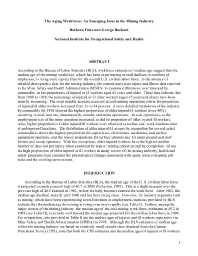Mining Publication: The Aging Workforce: An Emerging Issue in the Mining Industry
Original creation date: August 2000
According to the Bureau of Labor Statistics (BLS), workforce estimates of median age suggest that the median age of the mining workforce, which has been experiencing overall declines in numbers of employees, is rising more rapidly than for the overall U.S. civilian labor force. In the absence of detailed demographic data for the mining industry, the current study uses injury and illness data reported to the Mine Safety and Health Administration (MSHA) to examine differences, over time and by commodity, in the proportions of injured or ill workers aged 45 years and older. These data indicate that from 1988 to 1998, the percentage of injured or ill older workers (aged 45 years and older) have been steadily increasing. The most notable increase occurred at coal mining operations where the proportion of injured/ill older workers increased from 24 to 44 percent. A more detailed breakdown of the industry by commodity for 1998 showed the highest proportions of older injured/ill workers (over 40%) occurring in coal, iron ore, alumina mills, cement, and trona operations. In coal operations, as the employment size of the mine operation increased, so did its proportion of older injured/ill workers. Also, higher proportions of older injured/ill workers were observed at surface coal work locations than at underground locations. The distribution of older injured/ill miners by occupation for several select commodities shows the highest proportions for supervisors, electricians, mechanics, and surface equipment operators, and the lowest proportions for surface laborers and for underground coal roof bolters and scoop operators. With few exceptions, older injured workers have the highest median number of days lost per injury when examined by type of mining operation and by occupation. Given the high proportions of older injured or ill workers in many sectors of the mining industry, health and safety programs must consider the physiological changes associated with aging when evaluating jobs tasks and the working environment.
Authors: BA Fotta, GR Bockosh
Conference Paper - August 2000
NIOSHTIC2 Number: 20022037
Proceedings of the 31st Annual Institute on Mining Health, Safety and Research, Roanoke, Virginia, August 27-30, 2000. Bockosh GR, Karmis M, Langton J, McCarter MK, Rowe B, eds., Blacksburg, VA: Virginia Polytechnic Institute and State University, 2000 Aug; :33-45
See Also
- Passive Fiber Optic System for Locating, Tracking, and Communicating with Personnel in Coal Mines
- Post-Explosion Observation of Experimental Mine and Laboratory Coal Dust Explosions
- Refuge Alternatives in Underground Coal Mines
- Remote Methane Sensors
- Results of In-Mine Research in Support of the Investigation of the Sago Mine Explosion
- Risk Profile of Cumulative Trauma Disorders of the Arm and Hand in the U.S. Mining Industry
- Safe and Economical Inerting of Sealed Mine Areas
- Technical Solutions for Enhancements to Mine Safety Using Barricade II Fire Blocking Gel
- Underground Coal Mining Injury: A Look at How Age and Experience Relate to Days Lost from Work Following an Injury
- Wireless Mesh Mine Communication System
- Page last reviewed: 9/21/2012
- Page last updated: 9/21/2012
- Content source: National Institute for Occupational Safety and Health, Mining Program


 ShareCompartir
ShareCompartir
